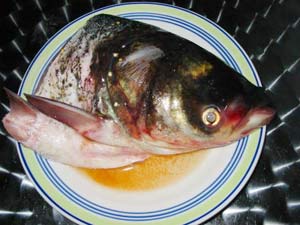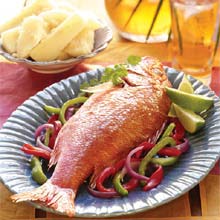The hot summer is also examination season, and students often experience mental stress, making it essential to consume fish head soup to nourish overall health and brain function.
 |
|
Fish heads are a nourishing food and tonic |
Fish heads are considered a nourishing food and tonic, helping individuals address the condition of “excess yang and insufficient yin.”
According to Western medicine, fish contains easily digestible protein with many valuable amino acids, omega-3 and omega-6 fatty acids, vitamins, minerals, calcium, phosphorus, zinc, pyroglutamate, and other essential nutrients that are crucial for brain development, nerve signal transmission, and memory enhancement.
Fish and fish heads can be prepared in a variety of dishes. Among them, fish head soup is popular due to its affordability and nutritional value for the brain. Particularly, students during exam season greatly benefit from consuming fish head soup to nourish their body and mind.
Following the new trend of promoting yin nourishment and antioxidant properties, darker foods are being prioritized, such as black snakehead fish, black carp, and black tilapia. Other options include white carp, red tilapia, white snakehead, and catfish.
Traditional Chinese medicine categorizes fish head soup into two types: “Clear broth”, which consists only of fish heads with minimal seasoning; and medicinal soup, which includes additional herbal ingredients according to specific ailments. The clear broth is generally preferred for preserving the delicious, aromatic flavors of the food while still maintaining its medicinal benefits. Herbal ingredients should only be combined when absolutely necessary to focus primarily on healing.
When preparing fish heads, it is advisable to include a portion of meat from the body, about 3-5 cm, to enhance nutrition and make the dish visually appealing. Additionally, include the liver but avoid letting the bitter bile mix in, as it can ruin the dish’s flavor and make it excessively cold.
How to Cook Fish Head Soup
 Using vegetable oil to fry the fish heads before cooking can add more nutrients. Fish soup is typically served with various vegetables, tomatoes, pineapple, bean sprouts, herbs, and spices like ginger, onion, garlic, and chili, which are rich in vitamins A, E, C, and essential minerals such as calcium, phosphorus, zinc, and iron.
Using vegetable oil to fry the fish heads before cooking can add more nutrients. Fish soup is typically served with various vegetables, tomatoes, pineapple, bean sprouts, herbs, and spices like ginger, onion, garlic, and chili, which are rich in vitamins A, E, C, and essential minerals such as calcium, phosphorus, zinc, and iron.
If enjoying fish head soup in a hot pot style with 3-4 fish heads, you can add tofu and shiitake mushrooms to provide additional nutrition for the brain, promoting mental clarity. For a sour soup, use sour fruits like pickled plums or tamarind, which are rich in vitamin C, but be cautious as excessive sourness can be harmful, especially for those who need to avoid sour foods or are suffering from high fevers (as sourness can aggravate their condition).
Clear fish head soup can be consumed directly, with rice, noodles, or bread, and the broth can be used to cook porridge (depending on the individual’s needs for fish head soup). These combinations will enhance the nutritional value of the fish heads for the brain since the starch in grains is essential for brain function. For noticeable health improvement, it is recommended to consume this soup for several consecutive days (at least 3-5 days). Regular consumption is safe and should not become monotonous.
Some Ways to Use Medicinal Fish Head Soup
Brain Nourishment: Clean the fish head, removing scales and gills, rinse in cool water, then blanch in hot water and fry lightly. Add a bit of white wine and ginseng (3g sliced and soaked in warm water) and boil, then add some seasoning and simmer for another 10 minutes. Consume the fish and drink the broth. This is suitable for individuals experiencing nervous exhaustion, forgetfulness, or anxiety.
Headaches, Dizziness, Nervous Exhaustion: Use one fish head, remove the fins, blanch in boiling water to eliminate any fishy smell, marinate with white wine and spices for 10 minutes. Steam 20g of Gastrodia elata until soft and cut into pieces. Place the fish head in a bowl, add the Gastrodia, garlic, ginger, cover, and steam until cooked, then sprinkle with pepper and serve hot or steam with smoked pig’s trotters, shiitake mushrooms, or chicken soup.
Nourishing the Brain, Calming the Mind, Boosting Qi, and Nourishing Blood: Use one snakehead fish (minimum 50g), 12g of ligusticum, 15g of prepared Chinese fleece flower root, 30g of astragalus, a bit of fresh ginger, and red dates (seedless). Combine all ingredients in a pot with an adequate amount of water. Boil over high heat and then reduce to low heat to simmer. Season to taste. Consume both the ginger and dates along with the broth. This recipe is beneficial for those who are forgetful, slow to respond, fatigued, dizzy, or have poor appetite.
Wind Cold Symptoms: Headaches, Neck Pain, Back Pain, Aversion to Cold, Prefer to Cover Head, Not Thirsty: Use one fish head weighing about 250g, 6-9g of white angelica, 3-9g of ligusticum, and a few slices of fresh ginger. Combine all in sufficient water to cook the fish, season, and consume for one day, continuously for 3-5 days or every other day over a week. This recipe promotes blood circulation, alleviates pain, and can also be used for various types of joint pain and stiffness. Do not use for headaches caused by internal injuries like high blood pressure.
Pregnancy Support and Treating Edema in Pregnant Women: Use one carp head, 90g of winter melon cut into pieces, and a few slices of ginger in one liter of water. Cook until done to consume both the fish and the broth.
Nourishing women after childbirth to increase milk supply and recover quickly: Fish head soup with fresh ginger is recommended for frequent consumption.


















































